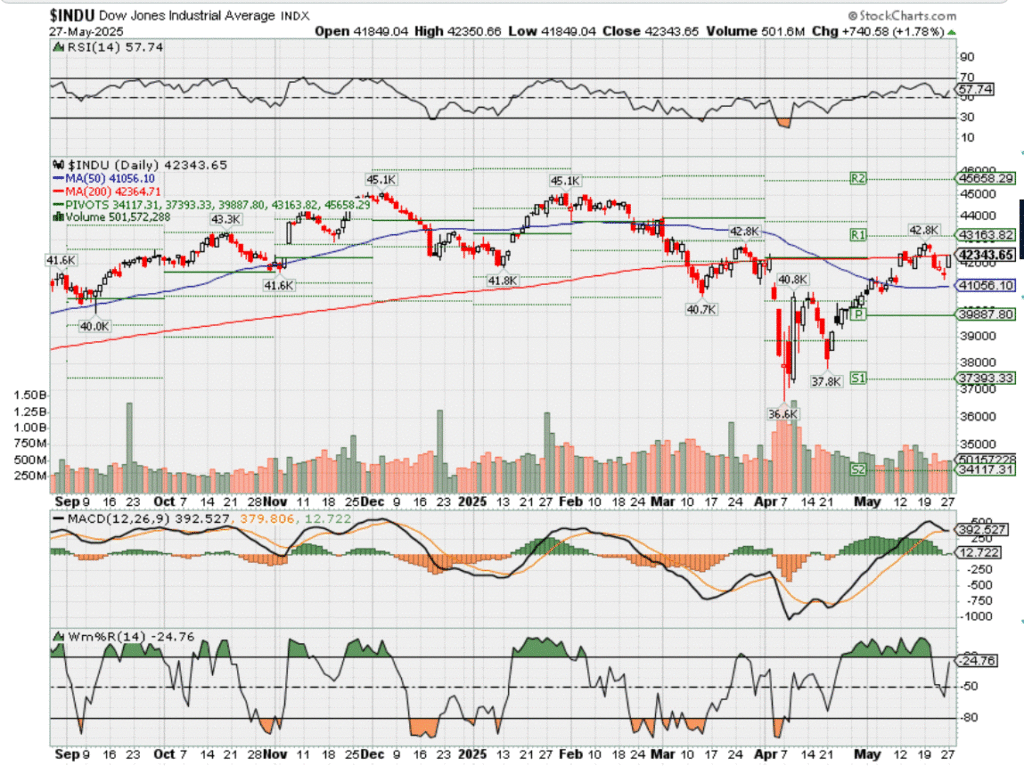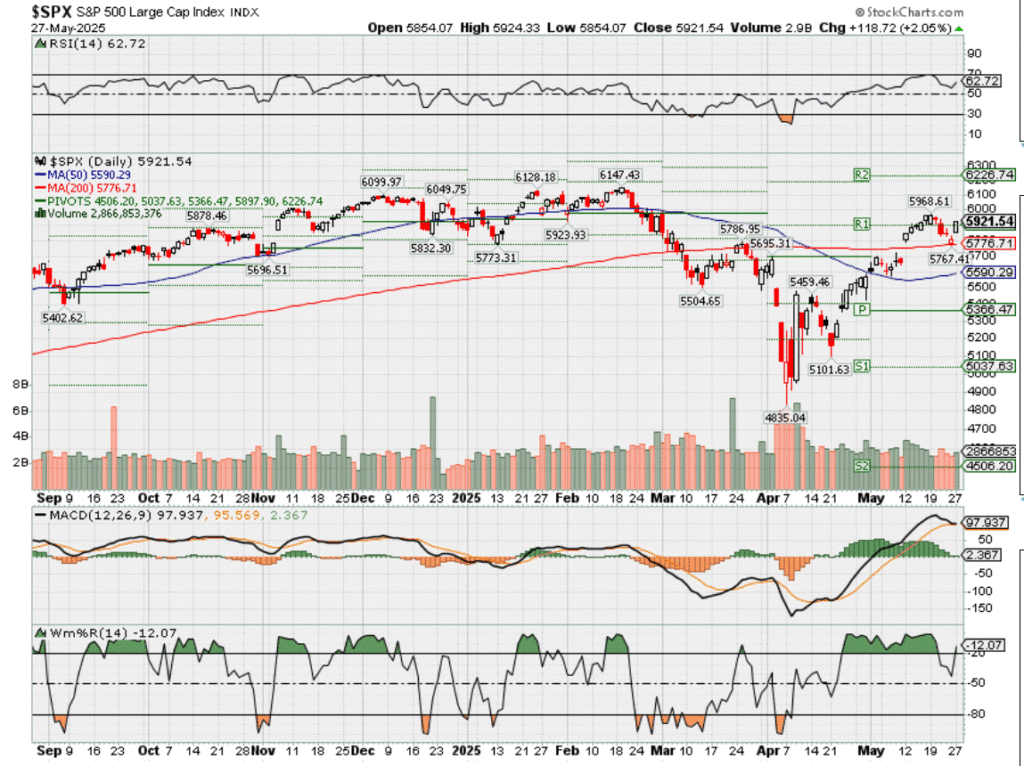HI Market View Commentary 05-27-2025
HI Market View Commentary 05-27-2025
Let’s review the Short call for some of you who asked questions about that option the last couple of weeks
Short Call = The Obligation to sell a stock at a certain price for a certain period of time.
Some of you were worried about having your stock called away. What do you do if you do not want the stock called away?=Buy it back, or roll it up and out in time for a net credit, let it go and buy back in with a stock replacement leap long call ( it should only use profits), buy to close it
YOU HAVE TO USE THE TOOLS THAT PROPERLY FIT THE TREND OF THE STOCK
The art of Trump – big talk and the backtrack/negotiate
Our concern is when does he get ticked off and let those tariffs run ?
Bonds vs Stocks = Stocks have a better opportunity
Bonds = 0% to 1% for ten years that’s 100% tax free
Are we in so much debt that we are going to lose our reserve currency status?= A basket of currencies would kill the USA
Thoughts on Harvard International Students ? The money and what the students did?
Can you blame Harvard for taking free money?-NOPE
IF the students singed a pledge for hating America, voiced the need to NOT protect the Isreal Country, Voiced and protecsted the USA/Trump?US Programs?+ IF they hate it here so much = Send them home.
1st Amendment right = protects freedom of religion, speech, press, assembly, and petition.
They protect freedoms =
Your thoughts?=Dumb, stupid,
For this year it’s going to be a roller coaster
Big movements on news, earnings, rate cuts, tax breaks,
Will are still in Mag7 / Rich Tech / Gig Balance sheet stocks because they DON’T need to borrow
Earnings
MU 06/25 AMC
NVDA 05/28 AMC
https://www.briefing.com/the-big-picture
The Big Picture
Last Updated: 23-May-25 17:13 ET | Archive
The Treasury market will tell the stock market where to go
Column Summary:
*Rising U.S. debt and deficits are pushing Treasury yields higher, raising investor concerns.
*Higher yields challenge stock valuations and make borrowing costlier for companies and consumers.
*Stronger earnings growth is needed to justify current stock valuations amid rising rates.
We have stressed often that earnings trends drive the stock market. When earnings are trending higher, the stock market tends to follow. When earnings are trending lower, the stock market may not follow that trend in direct lockstep, but it often gets locked on valuation concerns that interrupt its upward momentum and invite lower prices.
There may just be a new sheriff in town, though, dictating where the stock market goes. That would be the Treasury market.
Feeling Uncomfortable
U.S. Treasuries are deemed to be risk-free securities since they are backed by the full faith and credit of the United States of America, which is the steward of the world’s reserve currency. There have been some rumbles recently, however, about how risk-free U.S. Treasuries really are.
Moody’s downgraded the U.S. credit rating to Aa from Aaa, citing concerns about the increase in government debt and interest payment ratios hitting levels that are significantly higher than similarly rated sovereigns. It should be noted that the Moody’s downgrade came years after Standard & Poor’s and Fitch Ratings also cut their triple-A ratings for the U.S. In other words, the Moody’s downgrade wasn’t so much a shock in terms of its review of the U.S. fiscal situation as it was in terms of its timing.
It came in the midst of the House negotiating a reconciliation bill that some forecasting firms suggested could add as much as $5 trillion to the government’s budget deficit over the next 10 years. The House ultimately passed the reconciliation bill in a 215-214 party-line vote, sending it over to the Senate for consideration. The Congressional Budget Office said that, before accounting for interactions, the House’s version would add $2.3 trillion to deficits over the next decade and estimates it would add $3.1 trillion to the debt as it is written.
Buyers of Treasuries haven’t felt entirely comfortable with such forecasts and have started to demand a higher term premium — nothing exorbitant, mind you, but higher as they recognize more of the government’s budget will need to be allocated to paying the interest on the U.S. debt, which currently stands at $36.9 trillion, or 123% of nominal GDP.
Time Will Tell
The 10-yr note yield, which stood at 4.00% in early April, recently went as high as 4.63%. It currently stands at 4.50%, which is actually seven basis points less than when the year began.
That is an important distinction when it comes to tempering just how fearful the market has been about the budget negotiations, but the trend matters, and there is a nervous tension in the market that it is going to continue higher since it isn’t at all clear that the U.S. government’s fiscal trajectory will improve soon.
The counterargument is that the tax-friendly provisions of the reconciliation bill will ignite increased growth that makes up the deficit gap with increased tax revenues resulting from the stronger growth.
Only time will tell if that is the case, but rest assured the Treasury market will be keeping time, and the stock market is going to know if it is time for the U.S. government to make a more concerted effort to get its spending under control.
How will it know? Treasury yields will head higher in an unhinged fashion with so-called “bond vigilantes” selling their positions and/or balking at buying new supply that lacks, in their judgment, an adequate term premium.
Briefing.com Analyst Insight
This is a situation that could play out slowly over time or happen suddenly. With moves in Treasury yields, it isn’t always the level that stirs the stock market, as it is the pace of change. To that end, 4.50% is not a “high” yield, but considering it is up 50 basis points since early April, it has caused a stir that has slowed the stock market’s recovery momentum. In the same vein, the 30-yr bond yield of 5.03% is not “high” either, but it is also up 60 basis points since early April.
Source: FactSet
The stir is that these yields for risk-free securities are creating increased competition for stocks, which are not risk-free, and which have pushed the market cap-weighted S&P 500’s valuation back to a lofty 21.2x forward twelve-month earnings. That is a 16% premium to the 10-year average, according to FactSet — a premium that will demand stronger earnings growth to sustain.
Source: FactSet
That will be an increasingly challenging proposition if rates continue to rise, making it more expensive for companies to finance their debt and more onerous for consumers to take on new debt and/or to service existing debt with a variable rate structure. In the end, this all gets back to earnings driving the stock market.
Interest rates matter, and they are at risk of rising further if inflation rates start to accelerate due to the tariff actions and/or changes to the reconciliation bill by the Senate increase deficit forecasts.
That could be a problem for the stock market and the U.S. government, particularly if the Treasury market thinks it is a problem.
—Patrick J. O’Hare, Briefing.com
Where will our markets end this week?
Lower
DJIA – Bullish

SPX – Bullish

COMP – Bullish

Where Will the SPX end May 2025?
05-27-2025 +2.0%
05-19-2025 +2.0%
05-12-2025 +2.0%
05-05-2025 +1.0%
Earnings:
Mon:
Tues: AZO,
Wed: ANF, DKS, M, HPQ, NDSN, NVDA, CRM
Thur: BBY, BURL, FL, KSS, AEO, DELL, GAP, MRVL, NTAP, ULTA, COST
Fri:
Econ Reports:
Mon:
Tue Durable Goods, Durable Goods ex-trans, FHFA Housing Price Index, Case Shiller, Consumer Confidence,
Wed: MBA,
Thur: Initial Claims, Continuing Claims, GDP, GDP Deflator, Pending Home Sales
Fri: PCE Prices, PCE Core, Michigan Sentiment, Personal Income, Personal Spending, Chicago PMI
How am I looking to trade?
Mostly letting things run as we have since companies’ earnings
www.myhurleyinvestment.com = Blogsite
info@hurleyinvestments.com = Email
Questions???
The Republican spending bill is sending yields soaring and creating a major market headache
Published Wed, May 21 20253:54 PM EDTUpdated Thu, May 22 20257:41 AM EDT
Jeff Cox@jeff.cox.7528@JeffCoxCNBCcom
Key Points
- The U.S. debt-and-deficit situation is bad and facing real prospects of getting worse. Whether the recoil in financial markets continues is largely in the hands of policymakers.
- What it’s meant in market terms has been a severe leg up in Treasury yields and a sell-off in stocks.
- “I feel like the dam is finally starting to break a little bit, and there’s too many holes in the dike to put our fingers in,” said Mitch Goldberg, president of ClientFirst Strategy.
The U.S. debt-and-deficit situation is bad and facing real prospects of getting worse, triggering a high-profile credit rating downgrade from Moody’s and another selling stampede in stocks and bonds.
Whether the recoil in financial markets continues is largely in the hands of policymakers who seem intent on adding to the U.S. fiscal problems in the name of stimulating growth through President Donald Trump’s “big, beautiful” spending bill.
For now, Wall Street experts are not optimistic about what happens from here.
“Moody’s didn’t tell us anything we didn’t already know, but they did underscore that things aren’t going in the right direction,” said Kathy Jones, chief fixed income strategist at Charles Schwab. “The ‘big, beautiful bill’ also, when it comes to debt and deficits, is not going in the right direction.”
The result, Jones said, is that the U.S. is likely to add to its $36.2 trillion debt load, of which $28.9 trillion is directly held by the public. Tax cuts that aren’t matched with less spending or higher growth would also pressure the budget deficit, which is heading toward 7% of gross domestic product.
The bond market is in the driver seat for the equity market, says Charles Schwab’s Liz Ann Sonders
Moody’s Ratings on Friday cut U.S. debt from its top rating, though it changed the outlook from negative to stable. The agency cited unresolved “large annual fiscal deficits and growing interest costs” as the reason behind the move, though it did not specifically mention the House spending bill.
Add to that trade tensions the U.S. has initiated with Japan and China, the largest and third-largest foreign holders of Treasury debt, and it makes for a market headache.
“You put all that together, and the market is increasing that risk premium for long-term bonds,” Jones said. “There is a global repricing in a world where there’s just more sovereign debt and a lot more uncertainty about whether policies are going to adjust to make that look attractive.”
Jump in yields
What it’s meant in market terms has been a severe leg up in Treasury yields, particularly in longer-denominated debt such as the 10-year note and 30-year bond. Investors are demanding higher yields as compensation for the risk they are taking holding U.S. debt.
In normal times, Treasurys are considered risk-free investments as there is virtually zero risk the U.S. ever would default. However, rising worries about the fiscal situation and a resurgence in inflation from tariffs — not to mention the Moody’s downgrade — are forcing yields higher.
30-year yield over the past five days
With the deficit heading to 6.5%-7% of GDP, that is “inconsistent with debt-to-GDP stability over the long run,” Matthew Luzzetti, chief U.S. economist at Deutsche Bank, said in a client note. “Absent a clearer commitment towards putting deficits on a downward path, investor concerns about U.S. fiscal dynamics are likely to persist.”
How much the budget will get stretched is dependent on the final package that gets through Congress. House Republicans on Thursday passed their version of the 1,000-page spending bill that preserves much of the Trump’s pet items while adding come concessions to GOP deficit hawks.
The version that heads to the Senate makes the 2017 tax cuts stay and eliminates taxes on tips and overtime. Markets believe that with only partial revenue offsets, will aggravate the fiscal problems, even though advocates of the bill insist that economic growth will make up for any direct tax losses.
“If [the bill] fails, the financial markets won’t be happy. But if it passes — well, that might be just as problematic,” wrote Ed Yardeni, head of Yardeni Research. “Why? Because budget deficits matter. That’s especially so when they lead to higher interest rates, higher bond yields and potentially higher inflation. We suspect the Bond Vigilantes already anticipate this.”
Stocks also under pressure
Long yields continued their march higher Thursday morning, with the 30-year bond hitting 5.13%, its highest since October 2023 and an area where it hasn’t traded consistently since the early part of the century. The 10-year note, used as a benchmark for a wide range of debt, from auto loans to mortgages, topped 4.6% on Wednesday, its highest since February.
The market damage, though, hasn’t been limited to fixed income, nor has it been confined to the U.S.
10-year yield in past five days
Stocks also have come under pressure as investor nervousness grows over how higher interest rates will pressure corporate profit margins, raise borrowing costs and slow consumer spending. After easing somewhat from 7% earlier this year, 30-year mortgage rates are climbing again, most recently at 6.81%, according to Fannie Mae.
Bond yields also are rising globally. The 30-year Japanese government bond yield is at a record high as worries over fiscal stability spread.
“I feel like the dam is finally starting to break a little bit, and there’s too many holes in the dike to put our fingers in,” said Mitch Goldberg, president of ClientFirst Strategy. “The issue is that if the cost of debt financing keeps going up, we’re going to find ourselves in a time of austerity, kind of like the European Union was about 10 years ago.”
For equity investors, the changing dynamics of a deglobalizing economy likely mean permanently higher interest rates, potentially slower economic growth and a complicated market picture.
“We’re going to be facing 20% plus moves more frequently in the stock market,” Goldberg said. “It’s not just a new debt financing regime we’re facing. It’s a whole new global economy regime.”
These oversold stocks could be due for a pop after this week’s market declines
Published Sat, May 24 20258:42 AM EDT
Pia Singh@in/piasingh72/@pia_singh_
Stocks that investors dumped this week could make a comeback, according to one popular metric.
All three of the major averages dropped more than 2% this week. On Friday, the S&P 500 posted a fourth consecutive losing session and the Dow Jones Industrial Average lost more than 250 points after President Donald Trump called for a 50% duty on the European Union and threatened 25% tariffs on Apple for iPhones that are made outside the U.S.
Although volatility remains in the market, one widely used technical analysis metric indicates that certain stocks look oversold after this week’s losses and could be due for a near-term bounce.
Using the CNBC Pro stock screener tool, we identified the most oversold and overbought stocks this week by their 14-day relative strength index. A result below 30 suggests a stock could be oversold and see gains ahead, while an RSI above 70 indicates that a stock is overbought and could trade lower.
Take a look at the oversold names below:
WALL STREET’S MOST OVERSOLD STOCKS
| Symbol | Company | RSI | Analyst Consensus | Upside to avg PT (%) |
| UNH | UnitedHealth Group | 22.3 | Buy | 33.6 |
| CPRT | Copart | 27.2 | Buy | 16.6 |
| KMX | Carmax | 27.5 | Buy | 33.5 |
| CAG | Conagra Brands | 29.3 | Hold | 20.2 |
| FICO | Fair Isaac | 29.5 | Buy | 34.4 |
| CPB | Campbell’s | 29.6 | Hold | 23.3 |
| KHC | Kraft Heinz | 29.7 | Hold | 16.3 |
Source: LSEG
A handful of consumer packaged goods giants are now considered oversold.
Kraft Heinz, the maker of Heinz ketchup and Kraft macaroni and cheese, made the list with an RSI of 29.7. The stock lost 5% this week, bringing its year-to-date losses to 14%. Still, analysts have a consensus hold rating and a price target that suggests 16% upside ahead.
Earlier this month, Reuters reported that Kraft is spending $3 billion to upgrade its U.S. factories, its largest investment in its plants in a decade, in order to defend its market share. The news came even as the company has cut its sales and profit forecasts.
Conagra Brands and Campbell’s are also considered oversold with an RSI of 29.3 and 29.6, respectively. Conagra dropped more than 2% this week, while Campbell’s slid 5.7%. Analysts’ price targets call for more than 20% upside for both stocks.
In early May, Conagra announced an agreement with Hometown Food Company to divest its Chef Boyardee product line for $600 million in cash.
Other oversold stocks include Carmax and UnitedHealth, which was was the most oversold stock last week. UnitedHealth’s RSI of roughly 22 this week is a step up from its reading of 14.9 last week, but the stock remains under pressure and is down more than 41% year to date.
Here are this week’s overbought stocks:
WALL STREET’S MOST OVERBOUGHT STOCKS
| Symbol | Company | RSI | Analyst Consensus | Up/downside to avg PT (%) |
| GEV | GE Vernova | 81.6 | Buy | -11.2 |
| MOS | Mosaic | 79.5 | Buy | 8.8 |
| INTU | Intuit | 77.7 | Buy | -2.1 |
| STX | Seagate Technology Holdings | 77.7 | Buy | -0.3 |
| NRG | NRG Energy | 77.3 | Buy | -1.3 |
| WDC | Western Digital | 77.1 | Buy | 15.4 |
| CF | CF Industries Holdings | 76.8 | Hold | 0.8 |
| CTVA | Corteva | 76.1 | Buy | 5.5 |
| JCI | Johnson Controls International | 75.6 | Buy | 3.1 |
| GE | GE Aerospace | 75.4 | Buy | -2.3 |
Source: LSEG
GE Vernova is the most overbought of the group with an RSI of 81.6. Shares of the energy equipment manufacturing company jumped 8.5% this week. It has surged 41% this year.
CNBC’s Jim Cramer said this week that GE Vernova is “at the heart of every major power trend there is,” except for solar, and that the company could stand to benefit from hyperscalers’ power-hungry artificial intelligence tech developments. Big Tech data centers could eventually be powered by GE Vernova’s natural gas turbines, Cramer said.
To be sure, analysts covering the stock think GE Vernova appears overvalued, and could see a decline of 11% from current levels.
Other overbought stocks this week are Intuit, NRG Energy and GE Aerospace. Tax software giant Intuit, which has an RSI of more than 77, saw its stock pop 8% on Friday after the company posted strong quarterly results and guidance. Intuit posted a weekly gain of 7.4%, and it’s up more than 14% in 2025.
China’s economy stumbles as it fails to shake off Trump’s tariff gut punch

New economic data shows key Chinese industries continuing to struggle in the wake of President Donald Trump’s reciprocal tariffs.
Retail sales, which track the sale of new and used goods to the general public, slowed to 5.1% in April, missing official projections for a 5.5% expansion, according to numbers from China’s National Statistics Bureau reviewed by Reuters. China’s industrial output fell to 6.1%, down from 7.7% the month before, as tariffs keep biting Chinese factories.
Following Trump’s tariffs taking effect, 16 million Chinese jobs were put at risk of vanishing, leading to layoffs and worker protests. Even though recent talks led to Tariffs being lowered from 145% to 30% over the next 90 days to allow for further trade talks, experts say China’s economy is not likely to rebound quickly.
“When you increase the tariffs to such a high level, many companies decide to stop hiring and to start basically sending the workers back home,” Alicia Garcia-Herrero, chief Asia Pacific economist at investment bank Natixis, told Reuters.
She estimated that if the tariffs were raised back to April’s level, China’s economy could slow by as much as 2.5%. Even in a best-case scenario, China’s economic growth is likely to stall.
“At 30%, I doubt they will say, okay, come back. Because it’s still high,” she added. “Maybe the Chinese government is saying, wow, this was amazing. But I think many companies are not sure that this is going to work.”
A policy advisor who spoke to Reuters on the condition of anonymity echoed that sentiment, calling the deal a “win for China.” They did suggest, however, that there would be issues with the country’s economic outlook.
”It’s difficult to do business at 30%,” the adviser added. “Over time, it will be a burden on China’s economic development.”
President Trump initially imposed a 10% tariff on Chinese goods, which reached 30% in early April, per a graph created by CNN. China responded with tariffs on American products like oil and natural gas after the U.S. raised tariffs to 104%. After China imposed a higher 125% tariff on all American goods, President Trump raised tariffs on China to 145%. Shortly thereafter, China’s economy began to slow.
China’s export industry saw new orders drop to their lowest level since 2022, while cargo shipments to the U.S. collapsed by 60%. The services sector hit a seven-month low, and China’s six largest banks reported that profits in the first quarter of 2025 were down almost $2 billion from the same time last year.
Chinese authorities have stopped publishing a wide range of key indicators in the last several years, including data on land sales, unemployment, and foreign investment, meaning the true numbers are probably much worse, according to a Wall Street Journal analysis. Hundreds of previously available metrics have quietly disappeared, usually without explanation, the Journal reports.
A well-known Chinese economist said publicly last year that China’s economic growth was much lower than what the Chinese Communist Party claimed. Chinese President Xi Jinping ordered that he be disciplined, and he has not spoken publicly since, the Journal reported.
Bernstein raises its price target on this stock with a ‘history of momentum’
Published Tue, May 20 20256:59 AM EDT
Pia Singh@in/piasingh72/@pia_singh_
FILE – A 13-year-old private Boeing aircraft that President Donald Trump toured on Saturday to check out new hardware and technology features, and highlight the aircraft maker’s delay in delivering updated versions of the Air Force One presidential aircraft, takes off from Palm Beach International Airport, Feb. 16, 2025, in West Palm Beach, Fla.
Ben Curtis | AP
Bernstein is doubling down on its bullish outlook on Boeing.
Analyst Douglas Harned maintained his outperform rating on Boeing shares and assigned a fresh price target of $249, up from $218. His new target suggests roughly 21% upside for the stock, which is up 16% this year.
Harned sees a strong growth runway for Boeing and said its defense business could return to being a powerful cash generator. He also highlighted recent developments such as Boeing’s restart of deliveries to China, its deal with Qatar Airways announced last week to provide up to 210 widebody jets and easing tariff concerns.
“Positive events support the stock’s upward momentum,” the analyst wrote in a Monday note to clients. “Last week, we saw large new widebody orders, a restart of deliveries to China, and support for defense programs, raising our confidence in Boeing’s growth path. There is still more upside potential.”
“None of this is without risk, given Boeing’s many missteps over the last decade. But, as positive elements appear to line up, we believe there is more risk in not owning a stock with a history of momentum,” Harned added.
To be sure, the analyst still has concerns about seemingly light May 737 deliveries so far and timing for certification on Boeing’s 737 Max 7 and Max 10 aircrafts.
Boeing Co
ANALYST CONSENSUS
29
Ratings
Buy
8 Strong Buy
12 Buy
8 Hold
1 Underperform
0 Sell
Current PriceLast updated | 11:36 AM EDT
202.10
-0.26 (-0.13%)
Highest Price Target
256.24
Average Price Target
213.40
Upside (5.38%)
Lowest Price Target
140.00
Harned’s rating comes nearly a month after he upgraded Boeing to outperform from market perform. The analyst had cited Boeing’s progress on 737 Max and 787 production ramps, improvement in defense performance, and strong cash position that outweighed concerns of tariff impacts as his reasoning for the upgrade.
Analysts polled by LSEG have an average price target on Boeing shares that indicate just 1% potential upside. Twenty of the 29 covering the stock have a strong buy or buy rating.
European insurance giants take $3.5 billion hit from Los Angeles wildfires — beating estimates
Published Sun, May 25 20257:10 PM EDTUpdated 5 Hours Ago
Financial losses stemming from the California wildfires earlier this year have risen to at least $3.5 billion for European insurance giants, according to CNBC’s calculations.
The insured losses, mainly from reinsurance claims, are being borne by 10 large, listed firms in Europe, mainly centered in Germany, the U.K., Switzerland and France.
LA wildfires cost European insurers $3.5 billion
| Ticker | Company | Cost, millions (USD) |
| MUV2-DE | Munich Re | 1,244.74 |
| HNR1-DE | Hannover Re | 714.30 |
| SREN-CH | Swiss Re | 630.00 |
| ZURN-CH | Zurich Insurance Group | 200.00 |
| HSX-GB | Hiscox | 170.00 |
| SCR-FR | SCOR | 167.48 |
| LRE-GB | Lancashire | 145.00 |
| CRE-GB | Conduit Holdings | 100.00 |
| CS-FR | AXA | 100.00 |
| BEZ-GB | Beazley | 80.00 |
Source: CNBC, Company Filings
Germany-listed Munich Re and Hannover Re, two of the largest reinsurance firms, together booked nearly $2 billion in losses. Switzerland-listed firms Swiss Re and Zurich collectively reported $830 million in hits.
London-listed companies Hiscox, Lancashire Insurance, Conduit Re and Beazley reported losses of amounting to nearly $500 million.
French companies Scor and AXA also reported $167 million and $100 million losses, respectively.
The total hit far exceeds the billion dollars expected from analysts in the immediate aftermath of the wildfires. While the total economic loss due to the disaster was expected to be around $50 billion, JPMorgan analysts had expected insured losses of around $20 billion.
Berenberg analyst Michael Huttner told CNBC that the losses were much larger than anticipated at most insurance firms because the wildfires were a “combination of unusual and big.” The uncontained nature of the wildfire was one factor leading to the large losses, he said.

watch now
VIDEO02:41
European insurance giants take $3.5 billion hit from Los Angeles wildfires
However, the analyst added that profits generated by the companies far exceeded expectations, and pointed to the resiliency of the sector amid large natural disasters.
In late April, Swiss Re further raised the estimate for insured losses to $40 billion from the LA fires, making it one of the deadliest and most expensive disasters for California.
The death toll from the wildfires that ravaged the greater Los Angeles area, covering Eaton and Palisades, rose to 30 after human remains were found among the charred houses. Millions have been displaced, and thousands of homes and buildings have been destroyed.
CNBC’s tally would leave European companies on the hook for nearly a tenth of total insured losses.

Here’s how climate change is reshaping home insurance costs in California — and the rest of the U.S.
Reinsurance firms offer policies to primary insurance providers, like Chubb, which are present in California and directly deal with customers on the ground. The reinsurance policies typically only kick in after about 400 million euros worth of losses are absorbed by the primary insurance provider.
Outside of Europe, Japanese reinsurers Tokio Marine and Sompo disclosed nearly 50 billion yen ($348 million) in losses, significantly higher than the $63 million estimated by JPMorgan analysts in the days after the fire.
If Swiss Re’s forecast for total insured losses comes to fruition, the Los Angeles wildfire would be four times more devastating than wildfires of the past.
Notable California wildfires
| Wildfire | Insured loss ($ billion) | Buildings affected |
| Camp fire (2018) | 10 | 18,804 |
| Tubbs fire (2017) | 10 | 5,643 |
| Woolsley fire (2018) | 5 | 1,643 |
| Atlas fire (2017) | 4 | 2,352 |
| Glass fire (2020) | 3 | 1,955 |
Source: JPMorgan, Jan. 10
In 2018, wildfires in California cost the whole industry around $16 billion in losses. During that event, Munich Re absorbed the largest share of the loss at 500 million euros. The experience of that disaster and others has led to per-event deductibles (or excess) rising from 100 million euros to 400 million euros today.
The losses to insurers, both in the U.S. and Europe, have also been partly reduced by the introduction of the FAIR Plan, a pooled fund built with contributions from multiple insurance providers in California. The system is expected to absorb the bulk of the losses first before private insurance companies begin paying out.
Trump delays 50% tariffs on EU to July 9
Published Sun, May 25 20256:27 PM EDTUpdated Sun, May 25 20257:57 PM EDT
Key Points
- U.S. President Donald Trump agreed to delay imposing a 50% tariff on European goods until July 9.
- “I agreed to the extension — July 9, 2025 — It was my privilege to do so,” Trump wrote on Truth Social.
- Ursula Von der Leyen, president of the European Commission, said that she needed until July 9 to “reach a good deal.”
President Donald Trump said Sunday that he agreed to an extension on the 50% tariff deadline on the European Union until July 9.
“I received a call today from Ursula von der Leyen, President of the European Commission, requesting an extension on the June 1st deadline on the 50% Tariff with respect to Trade and the European Union,” Trump wrote on Truth Social.
“I agreed to the extension — July 9, 2025 — It was my privilege to do so,” he added.
Trump’s post came after Von der Leyen said that she had a “good call” with Trump, but needed until July 9 to “reach a good deal.”
“The EU and US share the world’s most consequential and close trade relationship,” she wrote on X.
“Europe is ready to advance talks swiftly and decisively,” she continued.










